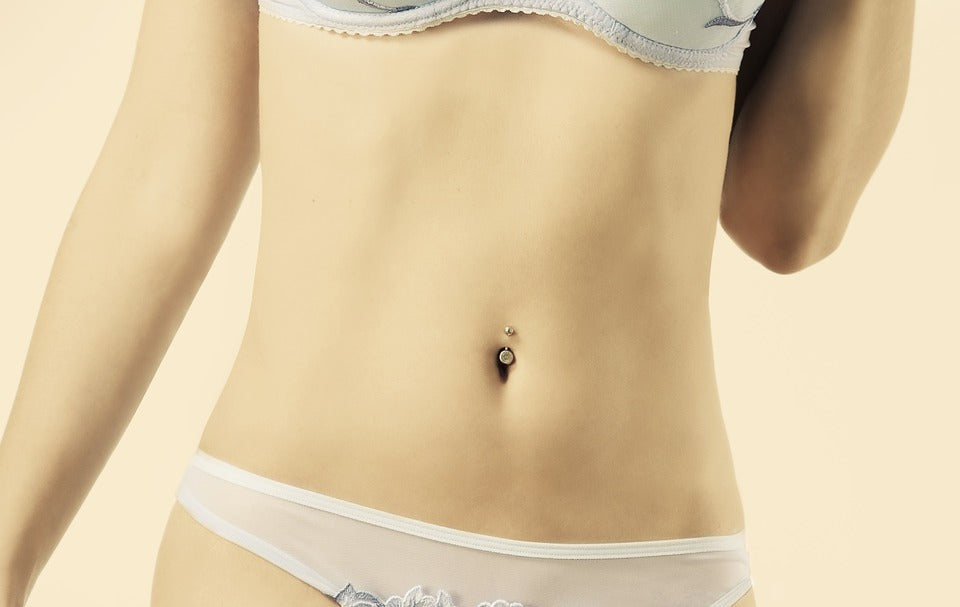Infected Belly Button Piercing Guide
Posted by Melissa Morganite on

Knowing how to tell if you have an infected belly button piercing can be difficult. Is it an infection or an allergic reaction? Knowing the difference can be very complicated because they look very similar. An infected navel piercing will be red, blotchy, and ooze a creamy and/or green colored puss. Belly button piercing infections are typically smelly and sticky (and a multitude of things can cause this).
Touching your new piercing with dirty hands, wearing clothing that is too tight, or wearing cheap/rough-edged jewelry can all aggravate your piercing. BUT if it’s extremely tender, swollen, and oozing puss, you should go straight to the doctor. The last thing that you want is an infection in your blood. If it's red and irritated, with just a little bit a creamy discharge, you should be able to handle this easily at home.
How to Clean a Belly Button Piercing
1. Make sure whenever you handle your piercing your hands are clean.
2. Make sure that the jewelry you are going to put in is also clean. This does not mean sticking it in your mouth and then sliding it into your piercing.
3. You should soak your jewelry rubbing alcohol for a minute or two before putting it in. If my belly button piercing is irritated, I like to use a tiny bit of Bacitracin on the end of the jewelry so when you push the jewelry through your piercing it slides easily through and coats the inside with the Bacitracin.
Note: I have heard mixed reviews from piercers in regards to using Bacitracin or antibiotic cream, but I have had good results personally and with my customers using this method.
4. I strongly suggest using a warm salt-water rinse a couple of times during the day especially if you have a creamy discharge. The warm salty water will loosen the discharge so it does not become crusty and cause reopening of the internal wound. You will see results fairly quickly that your piercing is healing, and the redness will go away.

Top 5 Ways You Can Get an Infected Navel Piercing
- Handling your piercing often and not washing your hands thoroughly.
- Wearing clothes too tight
- Opening the wound back up (making it open to bacteria).
- Swimming in dirty water, pools, hot tubs, lakes or oceans (all kinds of bacteria are in these bodies of water).
- Being allergic to the metal OR the metal is being pushed out of your body naturally because your body is rejecting it (this is called migration).
My Navel Piercing Pain Experience
I suffered horribly from migration and an allergic irritation because I was pierced with surgical steel my body was rejecting it. This is one of the reasons I invented TummyToys. I was doing everything that piercer recommended and what I had read online, but nothing helped.
It continued to be red itchy and blotchy, this was not a pretty look for the summer and I was extremely disappointed with the healing process. Click the following link to read more about my navel piercing pain story. As soon as I made my prototype (the very first TummyToys belly ring), I changed my captive bead ring out for my new clasp. I used salt water rinses, antibacterial soap in the shower, and Bacitracin. Within three days the itchy, red, blotchy mess had gone away.
So my recommendation is if you wear cheap earrings and your earlobes itch: opt for a higher quality metal to be pierced with. I recommend a titanium or niobium captive bead ring. The reason I recommend this style is your belly button piercing is not limited in any way. You can easily wash and clean the captive bead ring and it allows your piercing to swell if irritated, and for you to be able to clean it thoroughly (by moving it back and forth). A traditional barbell is extremely restricted and does not give you the ability to clean it thoroughly.
Infected Belly Button Piercing Conclusion
Everyone’s healing process is different but it is very common for naval piercing to take up to eight months to properly heal. Our body heals from the inside out. So the outside might look like it it’s fine but the inside is still raw. Each time you take jewelry in and out of your piercing you’re opening the wound back up again. As frustrating as it might be, don’t change your jewelry until all of the tenderness has gone away. You might be one of the lucky ones and that means only a couple of months. For me it was over a year.
